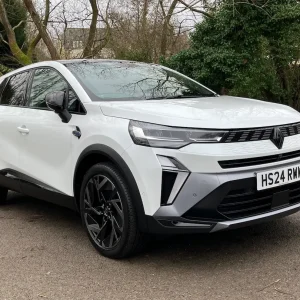Despite the choice of models in the mid-size class growing massively over the past year, we felt none of them could match the i4’s reliable electric range, driver appeal, and practical hatchback design. So, it maintained its ‘Best Electric Car – Over £40,000,’ award at the 2023 Business Car Awards.
To open up the i4 to more fleet drivers, BMW has added eDrive 35 versions because of their lower entry price. Key changes take place under the i4’s hatchback body, with power down to 278hp from the less powerful electric motor – from the eDrive 40’s 335hp. As such, the 35 is also slightly slower, reaching 62mph in 6 seconds, compared to the 40’s 5.5 seconds. To be honest, on the road you hardly notice this power reduction of the eDrive 35 – as the responsive steering and engaging handling are unchanged, and in our opinion, this i4 is every bit as good to drive as the 40, or even the fastest M50 versions. Like our previous eDrive 40 long-termer, this MSport spec test car was on 18in alloy wheels, which rode confidently and compliantly.
The biggest change for the eDrive35 over the 40 is the range reduction, which is down from 365 miles to 299 miles – which in the winter cold, when we had this car, was closer to 200 miles. This is fine if long range is not so important, and the eDrive 35 can be charged at a rate of up to 180kW, meaning a 10 to 80% charge takes just 32 minutes.
On the road, the eDrive 35 drives exactly the same as the 40, so think the same responsive – if slightly over-light steering and engaging handling. In fact, the handling constantly makes you question whether BMW has accidentally fitted an ICE engine in the front – rather than the electric motor. The i4 really is almost as good to drive as its ICE model counterparts. The ride was comfortable in ‘Comfort’ mode and not too harsh in ‘Sport.’ Smartest feature in daily driving must be the regenerative braking, which is cleverly linked to the navigation and sensors used by the driver assistance systems, meaning the amount of recuperation is adapted to the road situation. It works really well.
Outside, the i4 remains an attractive car, and thankfully model year differences have only equalled a slight wheel design change, but this and subtle eDrive 35 badging are the only way to tell it apart from a similar eDrive 40 version.
Inside, the changes are also model-year related. The move to operating system 8.5 for the iDrive brings a sharper version, of what was already a good infotainment system. Also, seemingly like the rest of the BMW i EV range, the i4’s gear selector is now the slider type rather than the previous old-school gearknob.
Elsewhere, like before, space at the front is fine and the driving position is excellent. Legroom in the back of the i4 is more compromised, plus the curved roofline of the fastback shape eats into the available headroom. The i4’s hatchback opens up to reveal a practically shaped 470-litre boot.
We were told that early corporate demand for the i4 eDrive35 is split fairly evenly between the entry-level Sport and the M Sport version that we’re driving here. The Sport is still an attractive proposition for fleet, with all the key equipment covered, and a more affordable £49,995 starting price. Although if the budget can be stretched to the M Sport, like we have here, all bases are really covered in terms of the equipment
and finish.
Whatever i4 35 eDrive you choose, as long as you can live with the shorter range, in our opinion, it still remains the perfect car to move traditional company car buyers into EVs. It should also be given serious consideration against the Tesla Model 3 and Polestar 2.
BMW i4 eDrive 35 M Sport
P11D: £53,150
Residual value: 44.2%
Depreciation: £27,850
Fuel: £3,996
Service, maintenance and repair: £2,707
Cost per mile: 57.58p
Range: 299 miles
CO2 (BIK %): 0% (2%)
BIK 20/40% a month: £17/£34
Luggage capacity: 470 litres
Battery size/power: 78 kWh/278hp





